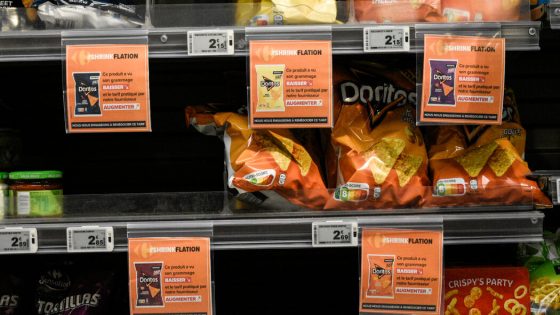For months, the shelves of Carrefour, France’s biggest supermarket chain, have been dotted with bright orange signs placed in front of Pepsi bottles, Lays potato chips and a variety of other foods whose packages are suspiciously smaller than they used to be.
“Shrinkflation,” the signs say. “This product has seen its volume decrease and the price charged by our supplier increase.”
On Friday, the French government took steps to require every food retailer in the country to follow suit. By July 1, stores will have to plaster warnings in front of all products that have been reduced in size without a corresponding price cut, in a bid to combat the consumer scourge known as shrinkflation.
“The practice of shrinkflation is a scam,” Bruno Le Maire, France’s finance minister, said in a statement. “We are putting an end to it.”
The government is also encouraging shoppers to act as informers, urging those “who have doubts about the price per unit of measurement displayed on the shelves” to flag it to authorities via France’s consumer reporting app.
The fight against the practice of downsizing products without also downsizing their prices has picked up in the United States, where President Biden has shamed food companies for raising prices even as inflation cooled.
Shrinkflation has become a point of outrage for shoppers in France, and a political flashpoint for President Emmanuel Macron as consumers continue to grapple with a cost-of-living crisis. Although inflation has recently come down in Europe from the record highs of a year ago, the prices of many food products remain elevated.
Inflation in the eurozone fell to a new two-year low in March, the result of an aggressive campaign of interest rate increases by the European Central Bank. European governments had also worked to ease prices for energy and food, through subsidies for electric bills and by negotiating with food manufacturers to force prices down.
In France, inflation has fallen now more than a third from a year earlier, but higher food prices have been persistent. A typical basket of food basics that includes items such as pasta and yogurt is 3 to 5 percent higher than it was a year ago, following a 16 percent surge for 2023.
Mr. Macron had promised to wrestle food costs down further this year. The government moved up annual price negotiations between suppliers and retailers in February, and put pressure on companies to limit increases.
The shrinkflation campaign is the latest weapon. Stores will have to display signs for two months after downsized products have been put on their shelves, according to the government decree issued Friday. The signs will appear near a variety of goods made by food companies, as well as for the supermarket’s private-label brands, from snacks and soda to bags of rice and laundry detergent. Prepackaged foods, like shrink-wrapped deli cold cuts or foods sold in bulk, will be exempt.
Many global consumer goods companies have raised prices by double-digit percentages in the past year, attributing the increases to higher costs of ingredients and labor. Even so, many of those companies have reported expanding profits as they sell fewer items at higher prices.
The issue came to a head in France last year when Carrefour announced that it would no longer sell PepsiCo products because the prices were “unacceptably” high for consumers, escalating a showdown by French retailers to name and shame brands that were not reducing prices as inflation eases.
As part of its campaign, Carrefour also put up shrinkflation posters next to products like Lipton tea warning shoppers that they were paying a higher price for a product whose volume had shrunk.
France has submitted a proposal to the European Union that would force food retailers throughout Europe to carry out a shrinkflation labeling campaign.
Source Agencies


